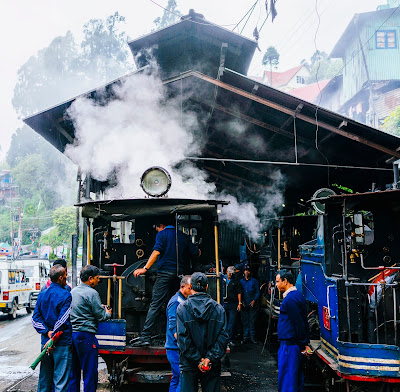 |
| Darjeeling Himalayan Railway |
 |
| Darjeeling Himalayan Railway YouTube |
: The 136-year-old Darjeeling Himalayan Railways (DHR), popularly called the toy train, is one of the oldest in the world established by the British during the colonial days. It is an engineering marvel that surpassed other mountain railway engineering work, the exception being NMR -Nilgiri Mountain Railway in Tamil Nadu. DHR is a UNESCO declared World Heritage site.
The following are the fascinating facts about DHR, one of the popular mountain railways in the world:
01. The railway track is a narrow gauge - 2 ft (610 mm) narrow-gauge railway that runs between New Jalpaiguri and Darjeeling in the Indian state of West Bengal, India, covering a distance 88 km (55 mi) from an elevation of about 100 m (328 ft) at New Jalpaiguri to about 2,200 m (7,218 ft) at Darjeeling.
 |
| Elysia Place,Kurseong.HQ-DHR image:Rangan Datta.en.wikipedia.org/ |
02. Built between 1879 and 1881, the train was hauled by steam locomotives, affectionately referred to as “Iron Sherpas” made in England some 100 years ago. The company that manufactured them stopped production of locomotives 60-65 years ago, Since the spares are not available, now Ranchi-based HECl has consented to imitate the spares and manufacture them for the steam locomotives.
03. The British-built B Class vintage steam locomotives handle daily tourist trains from Darjeeling to Ghum (India's highest railway and Kureong to Darjeeling return service. The Railways have 13 vintage steam locomotives out of which only six are operational. Once there were 34 narrow gauge steam locomotives operating on this route.
 |
| DHR B Class steam locomotive en.wikipedia.org/ |
 |
| DHR locomotivesen.wikipedia.org/DHR |
05.Before the advent of the railways, only Tonga services were available between Siliguri and Darjeeling and the road was slippery during the rainy season.
08.Credit goes to Franklin Prestage of East Bengal Railways who proposed the construction of a steam tramway from Siliguri and Darjeeling. The then Lt. Gov. of Bengal sir Asley Eden gave support to the project that was accepted in 1879. Work began in the same year.
10, The work completed in phases from Siliguri to Tindharia, later to Kurseong (opened on 28 August 1880. Following year, the stretch from here to Darjeeling was opened (4th July 1881).
11. To ease the steep gradient on the ascent between Sukna and Gayabari, loops and reverses (zigzags) were were laid in 1882. In 1886, the line was extended up to Darjeeling Bazaar, a brief stretch.
12. The track along the hill followed the Hill Cart road up to a point beyond which the gradient of the road was too much to handle.
13. Kurseong station came up in 1891, while Darjeeling station saw some improvement in 1886.
14. The trains were not operational between 1897 and 1899 as the track was damaged by a devastating earthquake. Again in 1934, the track was damaged by an earthquake originated in Bihar.
15. The mountain Railway service became so popular, between 1909 and 1910 DHR transported more than 170,000 passengers and hauled 40,000 tons of goods annually.
16. DHR was of great service to the British India Military during the WWI and WWII, transporting military personnel and supplies to the numerous camps around Ghum and Darjeeling.
17. Ghum railway station: It was at highest altitude worldwide and is the highest altitude station for a narrow-gauge railway.
 |
| DHR, Ghum railay stationen.wikipedia.org/ |
Above image: Ghum, railway station at 2257m (7407 ft), the highest point of Darjeeling Himalayan Railway
18. Soon after India's freedom in August 1947, DHR came under the administration of the Assam Railways organisation. In 1952, Assam Railway, including the DHR, came under the management of the North Eastern Railway Zone and later, in 1958, a part of the Northeast Frontier Railway zone of Indian Railway.
At present four diesel locomotives are operating along with six steam locomotives. But the use of the diesel engine is at variance with the conservation aspect of DHR as the UNESCO is very particular about maintaining its heritage value and authenticity - sort of a puritan form.
19. To access the new broad gauge line In 1962, the line was realigned at Siliguri and extended by nearly 4 miles (6 km) to New Jalpaiguri (NJP). In 1964, services began including freight.
20. During the tumultuous period of Gorkhaland Movement in 1988–1989, demanding separate state, the services were cancelled and the railways incurred loss.
21. On 2 December 1999, UNESCO declared DHR as a World Heritage site.
https://en.wikipedia.org/wiki/Darjeeling_Himalayan_Railway
http://www.newindianexpress.com/nation/2017/may/19/bengals-toy-train-gets-a-lease-of-life-1606707.html









